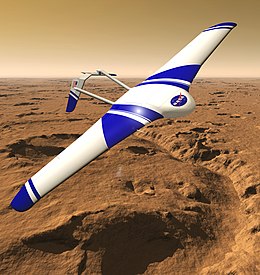 Simulation of ARES aircraft flying over Mars | |
| Mission type | Mars atmospheric probe |
|---|---|
| Operator | NASA |
| Website | mars |
| Mission duration | 1 hour on Mars |
| Spacecraft properties | |
| Power | watts |
The Aerial Regional-scale Environmental Survey (ARES) was a proposal by NASA's Langley Research Center to build a robotic, rocket-powered airplane that would fly one mile above the surface of Mars,[1] in order to investigate the atmosphere, surface, and sub-surface of the planet.[2][3][4] The ARES team, headed by Dr. Joel S. Levine,[5] sought to be selected and funded as a NASA Mars Scout Mission for a 2011 or 2013 launch window.[6] ARES was chosen as one of four finalists in the program, out of 25 potential programs.[7] However, the Phoenix mission was ultimately chosen instead.[8]
ARES would have traveled to Mars compactly folded into a protective aeroshell; upon entry in the thin atmosphere, the capsule would have deployed a parachute to decelerate, followed by ARES release at altitude.
As well as the aforementioned goals, the aircraft would also have investigated the atmosphere of Mars and its weak magnetic field.[9]
- ^ "NASA - Why We Do IT for NASA". www.nasa.gov. Retrieved 2021-01-18.
- ^ P.I: Joel S. Levine (November 20, 2009). "Aerial Regional-scale Environmental Survey". Archived from the original on 28 March 2010. Retrieved 2010-03-25.
- ^ Lewis Page (24 November 2009). "NASA plans robot rocket aeroplane to fly above Mars". Space. The Register. Archived from the original on 23 March 2010. Retrieved 2010-03-25.
- ^ Stuart Fox (November 24, 2009). "NASA Robotic Rocket Plane To Survey Martian Surface". Popular Science. Archived from the original on 14 April 2010. Retrieved 2010-03-25.
- ^ "Spaceflight Now | Breaking News | NASA selects four Mars Scout mission concepts for study". spaceflightnow.com. Retrieved 2021-01-18.
- ^ Christopher A. Kuhl (March 2009), "Design of a Mars Airplane Propulsion System for the Aerial Regional-Scale Environmental Survey (ARES) Mission Concept" (PDF), Mars Mission Concept, p. 10, retrieved 2010-03-26
- ^ Levine, J; Blaney, D.L.; Connemey, J.E.P.; Greeley, Ronald; Head Iii, James; Hoffman, John; Jakosky, Bruce; Mckay, Christopher; Sotin, Christophe (2003-09-15). Science from a Mars Airplane: The Aerial Regional-scale Environmental Survey (ARES) of Mars. doi:10.2514/6.2003-6576. ISBN 9781624100949.
- ^ Grey Hautaluoma (Dec 21, 2007). "NASA Delays Mars Scout Mission to 2013". NASA. Archived from the original on 24 May 2011. Retrieved 2011-05-25.
- ^ "ARES - Ensuring Reliability". NASA - Langley Research Center. January 14, 2010. Archived from the original on 2010-03-29. Retrieved 2010-03-25.